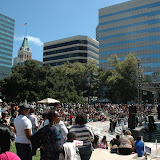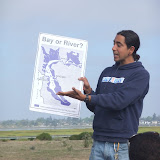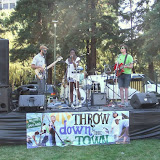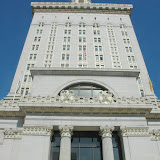One of the first women we heard about was Ina Coolbrith. She was the niece of Mormon founder Joseph Smith. Her family came to California and was led over the Sierra Nevada by African American mountain man Jim Beckwourth, with Ina riding on Beckwourth's horse. Ina is probably best known as a poet, and was the first California Poet Laureate. But she was also the first librarian of the Oakland Free Library (the 2nd public library in California), and befriended and mentored 10-year-old Jack London (he called her his "literary mother") and also mentored a young Isadora Duncan. Alas, the affections of Isadora's father for Ina may have led to the breakup of his marriage. Ina was also an honorary member of the Bohemian Club, had her portrait taken in her later years by a young Ansel Adams, and was friends with Joaquin Miller (and helped him gain global fame.) Ina is buried in Mt. View Cemetery.
We also walked by the 7-story tall "Mitzvah, the Jewish Cultural Experience" mural. Amongst the people pictured are Gertrude Stein and Alice B. Toklas. I've blogged about Gertrude Stein before, so I won't repeat it here, but she was a remarkable woman. The mural is definitely worth checking out, but you need to be on foot to see it -- the mural is visible looking south on northbound Franklin between 14th and 15th. The mural also shows the dome of Temple Sinai, featured in the Churches and Temples walking tour. For better pictures of the mural, see Oaktown Art.
Nearby we admired the YWCA building designed by Julia Morgan. It was one of 17 YWCA buildings she designed around the west. Morgan is probably best known for designing Hearst Castle, but locally she designed El Campanil at Mills College, College Avenue Presbyterian, and an array of other buildings. Her name has come up during the "Borax" Smith and Churches and Temples walking tours, and doubtless will again. Julia Morgan is buried in Mt. View Cemetery.
Women of some means formed clubs and societies to further their educations and impact the world around them, as well as for social reasons. One such club was the Ebell Society, formed in Oakland in 1876, and named for Dr. Adrian Ebell. We saw the former location of the Ebell Society clubhouse on Harrison. Not far from that is the former Women's City Club of Oakland, now the Malonga Casquelourd Center for the Arts. It was built in 1928, and designed by Miller & Warnecke, and housed various women's clubs. There was a surge in the number of clubs after national suffrage was passed.
Women got the right to vote in California in 1911, and nationally in 1919. The first woman registered to vote in California was Clara Elizabeth Chan Lee, and was the first Chinese American woman to register to vote in the U.S. But it's interesting to note that suffrage in California didn't pass in Oakland and San Francisco, but was carried by Berkeley and the farm counties.
We then walked west, past Lincoln Square, to Pardee House, past Preservation Park, past the First Unitarian Church of Oakland (where Isadora Duncan gave her first dance recital in 1890), and finished at the African American Museum and Library of Oakland (which the Ebell Society helped raise funds for).
some names from the tour:
- Ina Coolbrith
- Gertrude Stein
- Julia Morgan
- Isadora Duncan
- Ida Louise Jackson - education and public-health pioneer, first African American to teach in Oakland schools
- Clara Elizabeth Chan Lee
- Dorothy Ng - started a hospitality hall for Asian soldiers during WWII
- March Fong Eu
- Delilah Beasley - first African American woman to be published in a major US paper
- Jane Sather
- Madeline and Helen Pardee
more on Ina Coolbrith:
Wikipedia entry
"When the Grass Shall Cover Me" by Ina Coolbrith
Songs from the Golden Gate (free ebook)
more pictures:
 |
| women's history walking tour |



















































